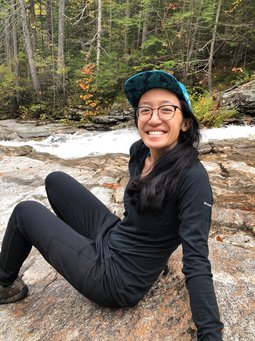A bridge over colored waters: Kelly Luis discusses her NASA Postdoctoral Program Fellowship

Kelly Luis, Ph.D., is a NASA Postdoctoral Program Fellow at the Jet Propulsion Laboratory Water and Ecosystems Group. A native of Hawaii, Luis studies what the color of water can tell us about the health of aquatic ecosystems. During her conversation with host Michael Holtz, Luis talks about the trajectory of her career, how she is contributing to science at NASA, obstacles she's overcome to get to where she is, and so much more.
Center: Jet Propulsion Laboratory
It took leaving her birthplace of Maui, Hawaii, and attending Columbia University for Kelly Luis, Ph.D., to discover her love of aquatic science.
When Luis entered Columbia University as a freshman, she was pursuing political science and economics. Luis understood the importance of environmental issues to the people of her native Hawaii, whom she hoped to represent one day. So, she enrolled in an introductory earth sciences course.
“I was coming from a social sciences background, and I was one of few women of color in the class,” Luis explained in a recent interview for “Further Together: The ORAU Podcast.” “So, I was just completely out of my depth, and super uncomfortable.”
However, Luis’s imposter syndrome disappeared when the instructor went over lava flows.
“I was just soaking everything in, writing everything down,” Luis continued. “And then they were talking about the two types of lava flows that scientists use. One is called pahoehoe, which is a smooth and broken lava. And then the second one is a'a, which is stony rough lava. And those are two Hawaiian words. And those words have been used in volcanism since the 1880s to describe the states of lava. But I remember being in that moment and thinking, ‘look—part of my culture is within this STEM world, and I never would've expected it!’ And I think that for me was a moment where I thought, ‘some of my language is here and maybe STEM could be for me.’”
Luis changed her major and went on to earn her bachelor’s in environmental science from Columbia University in 2015, and later completed her doctorate in marine science and technology from the University of Massachusetts in 2021.
“I came to aquatic remote sensing science because I fell in love with this concept of studying the color of water,” Luis explained. “The idea is that the color of water can tell us a lot about what's in the water, can extend to what we think about aquatic health and the function of aquatic ecosystems. And really when I learned that we had satellites that actually use this concept of color to understand primary production across the ocean—so with water quality, I just thought, ‘this is so cool.’ Growing up in Hawaii, just knowing that the color I see is something that's a science objective of NASA's. It was really my hook.”
Luis is now a fellow in the NASA Postdoctoral Program (NPP), where she conducts research as an aquatic ecosystem scientist at the Jet Propulsion Laboratory (JPL). She has been at the Jet Propulsion Lab since 2023.
“The NPP has been really incredible for me because I've had this opportunity to develop skills across multiple projects,” Luis continued. “One of the things that I'm really passionate about is thinking about how a measurement on the ground or something that you can measure with an instrument on a boat or see with your eye; how that color actually gets represented by an instrument on an airplane. And then how that extends to a satellite perspective. Because all of those scales of information, they say very different things.”
Luis went on to explain the history of ocean color study at NASA, and her own work in the field.
“NASA has been measuring ocean color, since the seventies with the coastal zone,” she said. “And then they were able to relate that to different type of properties. And then in the late 90s, early 2000s, we have all of these sensors that are able to make these measurements and they actually can provide really important information about how photosynthesizing materials in the ocean contribute to the global carbon cycle. How does this relate to general temperature changes we may be seeing with climate change, et cetera. So it extends to present days that we have new sensors that are going to be going up, that's going to continue that work, but also have more advanced technology on.”
Luis offered this analogy to help describe the advances in technology:
“We’ve had essentially five crayons to color the planet to infer its health about the ocean,” Luis explained. “But with these advanced sensors, we're not only at five, we now have hundreds of colors and all of those colors can tell you more specific information about what's happening in aquatic ecosystems. So that for me is really exciting about being an NPP and at NASA to see that development and to figure out what my questions are, what I'm interested in is going to support those larger missions.”
Luis explained that beyond finding a passion for her work, her STEM career and her NPP Fellowship have also brought her a community of mentors and peers who have given her both professional and moral support.
“When I think about JPL and NPP, the community I've met has been made up of incredible people who have also gone out of their way to make sure I'm okay, to support and empower me,” she said. “Academia is already a pretty lonely place—given my intersecting identities—and then to be in a space where there's really strong mentorship and people around me, for me that's just been probably one of the most empowering things: to meet people and think, ‘wow, I get to work next to you, with you.’ It's humbling at the end of the day for me.”
